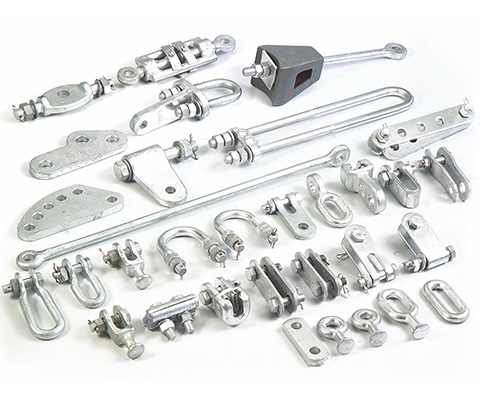Overhead line fittings are essential accessories used in power systems to connect and support various components, ensuring the eficient transfer of mechanical and electrical loads while providing protection.
These fittings play a crucial role in the power grid, where numerous cross nodes exist within the transmission and distribution network. At each intersection point, proper fixation is required to maintain structural integrity and electrical continuity.
The power grid consists of substations, which serve as intermediate nodes, and power towers, which suport the main transmission lines.To ensure the seamless transmission of electrical energy, overhead line fitings facilitate secure conductor contact andm aintain a suficient current-carrying capacity, enabling high-power distribution across the network.

The Concept of Overhead Line Fixtures
Overhead line fixturesareessential metal accessories used inpower transmissionsystems,typically made of iron, aluminum, or aluminum alloy.They play acrucial role in supporting and securing various components within the power grid.
These fixtures connect and support boost and buck substations, distribution equipment, and conductors,ensuring theseamless transmission of electrical energy.They also facilitate the connection between transmission line conductors, insulators, and supporting structures, forming a stable and efficient system.
In the context of overhead transmission lines, these metal accessories-often referred to as line fittings-serve several critical functions, including:
– Connecting conductors securely.
-Linking insulators into a string.
– Attaching insulators to transmission towers.
– Providing mechanical support and electrical continuity.
Overhead line fixtures must possess sufficient mechanical strength, durability, and flexibility to withstand high electrical loads and environmental stresses.As integral nodes in the power grid, their design and manufacturing adhere to strict safety standards to ensure reliable operation and structural integrity.
– Supporting structures
– Conductors and insulators
– Power control systems
– Electrical transmission lines
Eachof theseelementsrequiresongoing maintenance,makingnon-electricsystemsmorecost-attractive inthshorermowever,electrified rail systemcaneventuallyofsetheirinitialcosts through operational efficiency and reduced fuel dependency.
Another significant chaenge isthehigh cost permile forconstruction and maintenance, which makes overhead electrificationless practical for long-distance railways, particularly inregions like North America, where cities are far apart compared to Europe.Maintaining consistent power supply over extended distances requiressubstantial investment in infrastructure and poses significant logistical dificulties—especially in areas with limited energy resources.
Overhead Line Equipment
As a leading manufacturer of Overhead Line Equipment (Transmission Line Hardware), we understand that durability and safety are essential for the long-term success of any power transmission system. Every component within a transmission grid plays a critical role in maintaining structural integrity and operational eficiency.
This guide explores the key components of overhead line equipment, including:
– Connection Fittings – Essential for secure connections between conductors, connectors, and components.
– Insulation Fittings – Prevent electrical failures by ensuring proper insulation.
– Protection Fittings – Safeguard the system from electrical surges, lightning strikes, and environmental hazards.
– Suspension Clamps – Securely hold conductors in place while allowing movement and flexibility.
-Tension Clamps – Maintain proper tension to keep transmission lines stable and secure.
Electrical Overhead Line Equipment
Overhead line hardware is designed to ensure the efficient, safe, and reliable operation of power transmision systems.From connection fittings that establish secure electrical links to tension clamps that stailize transmission lines,each product ismanufactured withprecision and durability.
Using high-qualityoverhead lineequipment not only enhances the eficiency and lifespan of your power transmissionsystem but also minimizes downtime and ensures astable, uninterrupted power supply.
